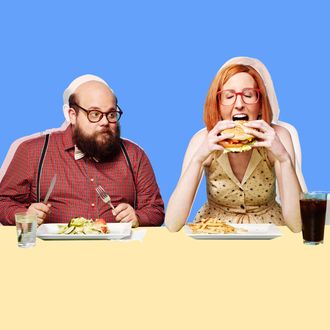
Chances are you can remember a time you ate way too much in a social setting. It’s really easy to do — not only are these the instances in which we’re most likely to be presented with a lot of food, but they’re also instances in which we’re surrounded by friends and acquaintances who are also stuffing their faces. A lot of research suggests there’s a contagious aspect both to this sort of gluttony and to having friends who can control themselves, and a recent study in Social Influence nicely sums it up.
For the study, a team of researchers from the universities of New South Wales and Toronto, led by Lenny R. Vartanian of UNSW, conducted a meta-analysis of past research on what’s known as “social modeling” of food intake, plucking out 38 different articles on the subject that varied somewhat widely in their experimental designs.
Overall, the researchers write, social modeling appears to have a “large effect” on the question of how much people eat in a given sitting. But there were some interesting nuances contained in the studies. For one thing, researchers “observed identical effect sizes for studies that used a live model versus a remote confederate.” In other words, if I bring you into a lab, sit you at a table with some Oreos, and tell you how much the last subject in the experiment ate, this knowledge appears to have about the same effect as having you participate in the experiment while someone scarfs down the cookies from across the table.
The authors also convey the good news that, in research settings at least, social modeling appeared to do a better job of reducing people’s intake than increasing it. They write:
We also found that inhibiting models tend to have a greater effect on people’s food intake than do augmenting models. Herman et al. (2003) argued that people are motivated to maximize their intake of palatable foods without appearing to eat excessively, and “excess” in social settings is defined as eating more than other people are eating. When the model eats very little, this sets a relatively low ceiling for acceptable food intake, leading people to suppress their food intake relative to how much they would eat if they were alone. In contrast, when the model eats a great deal, people essentially have the freedom to eat as much as they typically would and may even have permission to eat somewhat more than they typically would (as indicated by the relatively small difference between the high-intake conditions and the eat-alone control condition).
One obvious question: If I’m modeling my dining companion, then isn’t my dining companion also modeling me? (If so, they should be prepared to eat lots of pizza.) Or can one person dominate the modeling? The researchers point out that some earlier studies have shown links between social modeling and empathy and expressiveness — that is, the more someone has these traits, the more likely they are to be influenced by the people wolfing down (or daintily nibbling) food around them.
So it seems possible that differences in those and other important traits could help determine the answer (the more expressive person in a duo, for example, ends up being more affected by modeling). Overall, though, researchers aren’t sure yet — the authors write that “it would be interesting for future research to examine which factors determine who will lead and who will follow in naturally occurring social eating situations.” If that research involves consuming as much pizza as I can — or as much as I believe to be socially appropriate — I’d like to officially volunteer.




